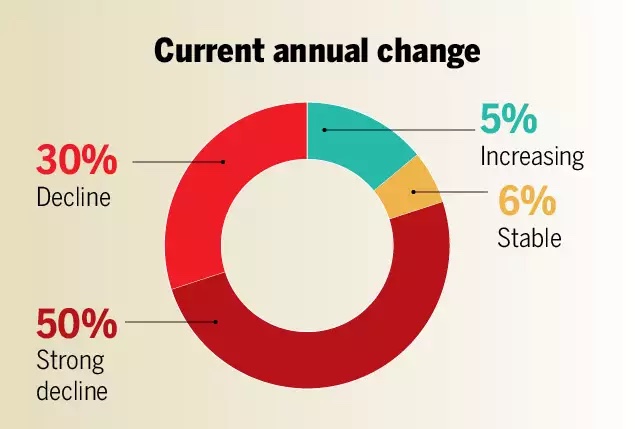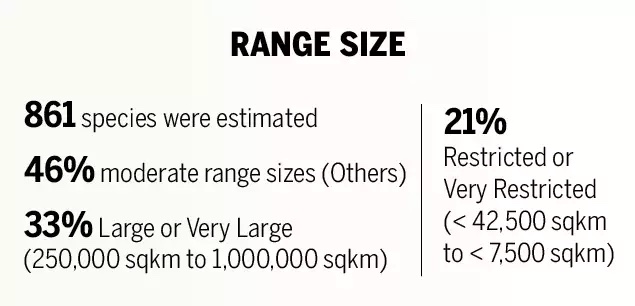Endangered animal species: India
This is a collection of articles archived for the excellence of their content. |
Contents |
YEAR WISE STATISTICS
2000- 2018
Vishwa Mohan, February 18, 2020: The Times of India

From: February 18, 2020: The Times of India

From: Vishwa Mohan, February 18, 2020: The Times of India

From: Vishwa Mohan, February 18, 2020: The Times of India

From: Vishwa Mohan, February 18, 2020: The Times of India

From: Vishwa Mohan, February 18, 2020: The Times of India
Over 50% of Indian species of birds might have reported a decline in their long-term and current population trends over the past decades, but the outlook for Indian peafowl (peacock and peahen) shows an improvement with the country’s national bird now being sighted even in states which were not deemed suitable for their survival 25 years ago.
Though the peafowl’s population has increased throughout its distribution range, this legally protected species has found additional homes in Kerala and Thar desert in Rajasthan — regions where it remained absent in the past as extremely wet or extremely dry areas are not hospitable habitats for the bird. “The reasons for this pattern have not been investigated in detail, but expansion into Kerala may be associated with an overall drying trend, and expansion into the Thar desert appears to have accompanied the spread of canals and irrigation,” said the State of India’s Birds 2020, released on sidelines of 13th Conference of Parties (COP13) to the UN Convention on Migratory Species in Gandhinagar.
The other bit of good news emerging from this birdwatchers’ report concerns the familiar house sparrow with its overall population trend remaining stable during the past 25 years despite its gradual decline in six large metro cities — Delhi, Mumbai, Kolkata, Chennai, Bengaluru and Hyderabad — and other urban centres.
The report also noted that there is no current evidence to support the popular theory that radiation from mobile phone towers could have affected sparrow population in cities. This pioneering report assesses the status of 867 Indian birds using a massive database of information contributed by over 15,500 birdwatchers. Using data uploaded by birdwatchers to the online platform eBird, the report identifies species that are high in conservation concern, and those that are doing relatively well. The report, however, does not give the number of birds in absolute terms.
2014


2015: Assistance by centre for protection
The Times of India, Jul 09 2015

Vishwa Mohan
Govt sanctions Rs 20cr to save five endangered animals
Waking up to the dwindling number of certain endangered species, the Centre has decided to step up efforts to protect five of them -Dugong (sea cow), Gangetic dolphin, Great Indian Bustard, Manipur brow antler deer (Sangai) and wild water buffalo for now and take up others in due course. The exercise will include taking up habitat and speciespecific conservation measures, based on global standards. The states will also be approached to take part in these efforts through policy intervention while keeping in mind livelihood issues.Initial assistance of Rs 20 crore has been earmarked.The amount will increase once the government is able to unlock its Rs 38,000 crore fund by getting a proposed egislation to this effect passed during the monsoon session of Parliament.
Besides increasing forest cover of the country , the fund ying unspent for years with an ad hoc body -Compensatory Afforestation Fund Management and Planning Authority (CAMPA) -is also meant to protect endangered species of flora and fauna including conservation of wildlife reserves and ecologically sensitive areas.
The decision to spare Rs 20 crore for protecting five species was taken on Wednesday in the meeting of the National CAMPA Advisory Council (NCAC), chaired by environment and forests minister Prakash Javadekar. The council in its meeting sanctioned Rs 162 crore out of total Rs 250 crore unspent money that had got accumulated over the past five years. Though the Supreme Court had allowed the government to clear project sworks worth Rs 50 crore every year, the Centre could not spend the money.
Other initiatives include creation of city forests under 200 municipal bodies across the country through urban forestry' scheme, launching of `school nurseries' programme, setting up biomass-based power project in Arunachal Pradesh and monitoring of corals and mangrove in the Islands.
As in 2020: 3 species from India
Ten endangered species of migratory animals/birds from across the globe, including three from India (Great Indian Bustard, Asian Elephant and Bengal Florican), will be included in a special global list for protection under the ‘Convention on Conservation of Migratory Species’ (CMS) — an international treaty to protect such species throughout their range countries.